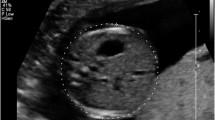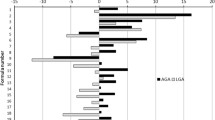Abstract
Studies in preterm infants show reduced speed of sound (SOS) as measured by quantitative ultrasound (QUS) during the immediate neonatal period. There is a scarcity of data on SOS changes following hospital discharge. The aim of this study was to assess SOS over the first 2 years in preterm infants. Infants were recruited from a neonatal follow-up clinic. Tibial QUS was performed using the Omnisense 7000P scanner. Thirty-nine infants born at <32 weeks’ gestation had a single SOS measurement (median 3,203 m/second, range 2,609–3,495) which correlated with corrected gestational age (CGA) (r = 0.8, P < 0.005). The majority of measurements were within the manufacturer’s reference range for term infants. SOS standard deviation score (SDS) in infants aged 0–6 months CGA demonstrated a negative correlation with duration of total parenteral nutrition (r = 0.7, P < 0.05) and a positive correlation with serum phosphate (r = 0.6, P < 0.05.) Two groups of infants had serial measurements: eight had measurements performed at term CGA and early infancy (early) and seven had measurements in later infancy (late). In the early group SOS SDS increased (P < 0.005), and the greatest increase in SOS over time occurred in infants with the lowest SOS at term (r = 0.9). In the late group there was no significant change over time. SOS SDS change did not show any correlation to weight SDS change. Catch-up in SOS occurs postterm in most infants by 6 months and is independent of postnatal growth. Infants with the lowest SOS at term have the fastest rate of catch-up. The opportunity for catch-up may be greatest in early infancy.


Similar content being viewed by others
References
Bishop N, Fewtrell M (2003) Metabolic bone disease of prematurity. In: Glorieux FH, Juppner HA, Pettifor JM (eds) In Paediatric bone biology and disease. Academic, San Diego, pp 567–579
Rauch F, Schoenau E (2001) The developing bone: slave or master of its cells and molecules? Pediatr Res 50:309–313
Rauch F, Schoenau E (2002) Skeletal development in premature infants: a review of bone physiology beyond nutritional aspects. Arch Dis Child Fetal Neonatal Ed 86:F82–F85
Dabezies EJ, Warren PD (1997) Fractures in very low birth weight infants with rickets. Clin Orthop 335:233–239
Koo WW, Sherman R, Succop P, Oestrich AE, Tsang RC, Krug-Wispe SK, Steichen JJ (1988) Sequential bone mineral content in small preterm infants with and without fractures and rickets. J Bone Miner Res 3:193–197
Fewtrell MS, Prentice A, Jones SC, Bishop NJ, Stirling D, Buffenstein R, Lunt M, Cole TJ, Lucas A (1999) Bone mineralization and turnover in preterm infants at 8–12 years of age: the effect of early diet. J Bone Miner Res 14:810–820
Jones CA, Bowden LS, Watling R, Ryan SW, Judd BA (2001) Hypercalciuria in ex preterm children, aged 7–8 years. Paediatr Nephrol 16:665–671
Dalziel SR, Fenwick S, Cundy T, Parag V, Beck TJ, Rodgers A, Harding JE (2006) Peak bone mass after exposure to antenatal betamethasone and prematurity: follow up of a randomised controlled trial. J Bone Miner Res 21:1175–1186
Specker BL, Johannsen N, Binkley T, Finn K (2001) Total body bone mineral content and tibial cortical bone measures in preschool children. J Bone Miner Res 16:2298–2305
Congdon PJ, Horsman A, Ryan SW, Truscott JG, Durward H (1990) Spontaneous resolution of bone mineral depletion in preterm infants. Arch Dis Child 65:1038–1042
Schanler RJ, Burns PA, Abrams SA, Garza C (1992) Bone mineralization outcomes in human milk-fed preterm infants. Pediatr Res 31:583–586
Pittard WB, Geddes KM, Sutherland SE, Miller MC, Hollis BW (1990) Longitudinal changes in the bone mineral content of term and preterm infants. Am J Dis Child 144:36–40
Bishop NJ, King FJ, Lucas A (1993) Increased bone mineral content of preterm infants fed with a nutrient enriched formula after discharge from hospital. Arch Dis Child 68:573–578
Raupp P, Poss G, von Kries R, Schmidt E (1997) Effect of a calcium and phosphorus enriched formula on bone mineralization and bone growth in preterm infants after discharge from hospital. Ann Nutr Metab 41:358–364
Horsman A, Ryan SW, Congdon PJ, Truscott JG, Simpson M (1989) Bone mineral content and body size 65–100 weeks postconception in preterm and full term infants. Arch Dis Child 64:1579–1586
Tsukahara H, Sudo M, Umezaki M, Fujii Y, Kuriyama M, Yamamoto K, Ishii Y (1993) Measurement of lumbar spinal bone mineral density in preterm infants by dual energy X ray absorptiometry. Biol Neonate 64:96–103
Backstrom MC, Kouri T, Kuusela AL, Koivisto AM, Ikonen RS, Maki M (2000) Bone isoenzyme of serum alkaline phosphatase and serum inorganic phosphate in metabolic bone disease of prematurity. Acta Paediatr 89:867–873
Lapillonne A, Salle BL, Glorieux FH, Claris O (2004) Bone mineralization and growth are enhanced in preterm infants fed an isocaloric, nutrient-enriched preterm formula through term. Am J Clin Nutr 80:1595–1603
Koo WK, Hockman EM (2006) Posthospital discharge feeding for preterm infants: effects of standard compared with enriched milk formula on growth, bone mass and body composition. Am J Clin Nutr 84:1357–1364
De Schepper J, Cools F, Vandenplas Y, Louis O (2005) Whole body bone mineral content is similar at discharge from the hospital in premature infants receiving fortified breast milk or preterm formula. J Pediatr Gastroenterol Nutr 41:230–234
Gianni M, Mora S, Roggero P, Mosca F (2007) QUS and DXA in bone status assessment of ex-preterm infants. Arch Dis Child Fetal Neonatal Ed. doi:10.1136/adc.2007.117945
Foldes AJ, Rimon A, Keinan DD, Popovtzer MM (1995) Quantitative ultrasound of the tibia: a novel approach for assessment of bone status. Bone 17:363–367 (erratum in Bone 1996;18:391)
Prins SH, Jorgensen LH, Jorgensen LV, Hassager C (1998) The role of quantitative ultrasound in the assessment of bone: a review. Clin Physiol 18:3–17
Njeh CF, Fuerst T, Diessel E, Genant HK (2001) Is quantitative ultrasound dependent on bone structure? A reflection. Osteoporos Int 12: 1–15
Rubinacci A, Moro GE, Noehm G, Terlizzi F, Moro GL, Cadossi R (2003) Quantitative ultrasound for the assessment of osteopenia in preterm infants. Eur J Endocrinol 149:307–315
Gonelli S, Montagnani A, Gennari L, Martini S, Merlotti D, Cepollaro C, Perrone S, Buonocore G, Nuti R (2004) Feasibility of quantitative ultrasound measurements on the humerus of newborn infants for the assessment of the skeletal status. Osteoporos Int 15:541–546
Yiallourides M, Savoia M, May J, Emmerson AJ, Mughal MZ (2004) Tibial speed of sound in term and preterm infants. Biol Neonate 85:225–228
Littner Y, Mandel D, Mimouni FB, Dollberg S (2003) Bone ultrasound velocity curves of newly born term and preterm infants. J Pediatr Endocrinol Metab 16:43–47
Nemet D, Dolfin T, Wolach B, Eliakim A (2001) Quantitative ultrasound measurements of bone speed of sound in premature infants. Eur J Pediatr 160:736–740
McDevitt H, Tomlinson C, White M, Ahmed SF (2005) The assessment of bone by quantitative ultrasound in preterm and term neonates. Arch Dis Child Fetal Neonatal Ed 90:F341–F342
Ritschl E, Wehmeijer K, De Terlizzi F, Wipfler E, Cadossi R, Douma D, Urlesberger B, Muller W (2005) Assessment of skeletal development in preterm and term infants by quantitative ultrasound. Pediatr Res 58:1–7
International Neonatal Network (1993) The CRIB (Clinical Risk Index for Babies) score: a tool for assessing initial neonatal risk and comparing performance of neonatal intensive care units. Lancet 342:193–198 (erratum in Lancet 1993;342:626)
Zadik Z, Price D, Diamond G (2003) Pediatric reference curves for multi-site quantitative ultrasound and its modulators. Osteoporos Int 14:857–862
Litmanovitz I, Dolfin T, Regev R, Arnon S, Friedland O, Shainkin-Kestenbaum R, Lis M, Eliakim A (2004) Bone turnover markers and bone strength during the first week of life in very low birthweight premature infants. J Perinat Med 32:58–61
Tomlinson C, McDevitt H, Ahmed SF, White MP (2006) Longitudinal changes in bone health as assessed by the speed of sound in very low birthweight preterm infants. J Pediatr 148:450–455
Kurl S, Heinonen K, Lansimies E (2003) Pre- and post-discharge feeding of very preterm infants: impact on growth and mineralization. Clin Physiol Funct Imaging 23:182–189
Albertsson-Wikland K, Karlberg J (1994) Natural growth in children born small for gestational age with and without catch-up growth. Acta Paediatr Suppl 399:64–70
Litmanovitz I, Dolfin T, Friedland O, Arnon S, Reger R, Shainkin-Kestenbaum R, Lis M, Eliakim A (2003) Early physical activity prevents decrease of bone strength in very low birth weight infants. Pediatrics 112:15–19
Finn K, Johannsen N, Specker B (2002) Factors associated with physical activity in preschool children. J Pediatr 140:81–85
Author information
Authors and Affiliations
Corresponding author
Rights and permissions
About this article
Cite this article
McDevitt, H., Tomlinson, C., White, M.P. et al. Changes in Quantitative Ultrasound in Infants Born at Less than 32 Weeks’ Gestation Over the First 2 Years of Life: Influence of Clinical and Biochemical Changes. Calcif Tissue Int 81, 263–269 (2007). https://doi.org/10.1007/s00223-007-9064-7
Received:
Accepted:
Published:
Issue Date:
DOI: https://doi.org/10.1007/s00223-007-9064-7




